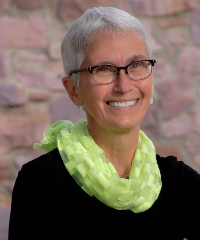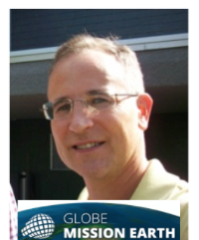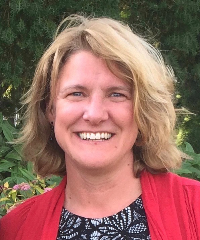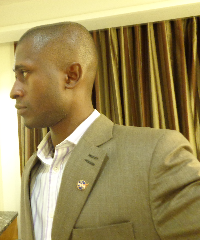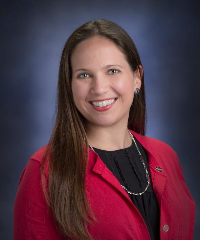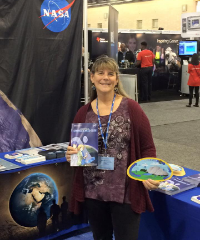Community Blogs
Community Blogs
Discover how the GLOBE community is engaging in all things GLOBE through the community blog posts below.
Learn how to create a GLOBE community blog post.
Filter By:
Blogs List
Research Questions: My experiment ran two adjacent triads of mosquito traps aimed to explore two questions: whether the local mosquito species in my area prefer to oviposit in containers with greater surface areas of water, and whether the same mosquitoes would prefer to oviposit in particular containers with varying types of water "bait".
Data: After 5 weeks of running this experiment, I failed to capture even a single mosquito larva. I'll go into further depth as to why this might've been later on in the "Conclusion" section. Both experiments suffered from a ...
Read More »
Posted in:
Curriculum:
STEM
GLOBE Science Topics:
EARTH AS A SYSTEM
EARTH SYSTEM SCIENCE
Investigation Areas:
EARTH AS A SYSTEM
MOSQUITOES
Primary Audience:
STUDENTS
TEACHERS
Student Research Reports:
INTERNATIONAL VIRTUAL SCIENCE SYMPOSIUM REPORT
MISSION MOSQUITO REPORT
*Last Updated July 14, 2022
Purpose: For my experiment, I am testing what color container and type of water mosquitos are most attracted to.
Background research: During the weekly science session with Dr. Alison Parker, I learned more about mosquito habitats and where mosquitos breed. Mosquitos lay their eggs in/near water, and mosquitos in their early larvae and pupae stages live in water. This information guided me to choose my AOI coordinates in an area with standing water. The coordinates on the red line in the picture run along a ditch that leads into a ...
Posted in:
Curriculum:
STEM
GLOBE Science Topics:
EARTH AS A SYSTEM
Investigation Areas:
EARTH AS A SYSTEM
MOSQUITOES
Primary Audience:
STUDENTS
TEACHERS
A video of me talking about the IOP is here:
https://youtu.be/gAwHjoCJNe0
The GLOBE October Intensive Observation Period (IOP) for urban heat island had great data collecting from around the world. Data was collected by students at over 70 schools and 1471 observations of surface temperatures wee taken. A list of all of the schools is listed below.
Here is a map and a picture from Earth Heart Farms near Oak Harbor, OH. Students took field trips to the farm and learned about conservation efforts. The took urban heat island observations.
You will see in the ...
Posted in:
Curriculum:
STEM
Field Campaigns:
SURFACE TEMPERATURE
Prof. Cristian Randieri is a great proactive person and an effective communicator and a visionary. His knowledge is not restricted to the area he covers, but his impressive passion for all the technical topics led him to acquire great skills even in areas far from his original studies. He is a valuable writer with a great scientific background formed with more than 15 years of active research on experimental Nuclear Physics performed in the most famous international research laboratories such as CERN, ESRF, INFN. He writes about HI-Tech solutions topics and advanced research studies ...
Posted in:
Curriculum:
ASSESSMENT AND EVALUATION
EDUCATION RESEARCH
SCIENCE AND MATH
TECHNOLOGY
STEM
Diversity, Equity, and Inclusion:
DIVERSITY, EQUITY, AND INCLUSION
Hello! My name is Margaret Gregory. I am a science writer for the USDA Forest Service. I found my way into the Forest Service through the Resource Assistant Program ; before that, I taught physical science and chemistry at a public high school for three years.
Even though I taught the physical sciences, my heart lies in the biological sciences—I minored in biology in my undergrad program. Photosynthesis forms the cornerstone of biology; if plants couldn’t create energy from sunlight, our world wouldn’t exist.
This lesson plan ...
Posted in:
Curriculum:
SCIENCE AND MATH
STEM
GLOBE Science Topics:
GENERAL SCIENCE
GLOBE PROTOCOLS
SCIENTIST SKILLS
Investigation Areas:
BIOSPHERE
Learning Activities:
LAND COVER/BIOLOGY
P4: A BEGINNING LOOK AT PHOTOSYNTHESIS
Primary Audience:
STUDENTS
TEACHERS
The Summer 2022 NASA SEES Internship program was a memorable one for the GLOBE Mission EARTH (GME) Team! The 6-week period of hard work, commitment, and dedication by all members led to creative and outstanding research projects from both the Urban Heat Island Effect (UHIE) and the Air Quality Initiative (AQI) Teams. The wide geographical spread of the NASA SEES students allows them to take observations using different GLOBE protocols across the United States.
The AQI Team led by GLOBE Mission EARTH Research Assistant Sara Mierzwiak and GME Teacher Janene Smith mentored a group of 7 ...
Posted in:
Curriculum:
EDUCATION RESEARCH
SCIENCE AND MATH
TECHNOLOGY
STEM
Diversity, Equity, and Inclusion:
DIVERSITY, EQUITY, AND INCLUSION
GLOBE International STEM Network (GISN):
GLOBE INTERNATIONAL STEM NETWORK (GISN)
Student Research Reports:
MISSION EARTH REPORT
My involvement in the Stem Enhancement in Earth Science (SEES) program started sometime around early spring 2021. The involvement was preceded by a strong recommendation from Dr. Kevin Czajkowski, PI, GLOBE Mission Earth, The University of Toledo.
Indeed, to me as a member of the GLOBE International STEM Network (GISN), my participation in SEES became an opportunity to invoke the GISN mandate which includes to mentor and inspiring ...
Posted in:
Curriculum:
ASSESSMENT AND EVALUATION
EDUCATION RESEARCH
SCIENCE AND MATH
TECHNOLOGY
STEM
Diversity, Equity, and Inclusion:
DIVERSITY, EQUITY, AND INCLUSION
Field Campaigns:
WATERSHEDS
SMAP
SURFACE TEMPERATURE
GPM
GLOBE Science Topics:
EARTH AS A SYSTEM
Investigation Areas:
ATMOSPHERE
HYDROSPHERE
PEDOSPHERE (SOIL)
BIOSPHERE
Learning Activities:
EARTH AS A SYSTEM
Primary Audience:
PARTNERS
SCIENTISTS
STUDENTS
Blog Contributors: Denise "Skye" Yost - GIO and Matthew Rodell - NASA
World Water Day (WWD) is right around the corner on 22 March 2022! WWD began in 1993 by the United Nations to celebrate freshwater, and bring awareness to use and conservation of freshwater resources across the globe.
This year, the theme for WWD is Groundwater. Groundwater is often misunderstood because it is not seen easily, unlike rivers, lakes, ponds, or oceans. But, groundwater plays a very important role in freshwater sources, specifically in providing moisture for plants to grow, and water for animals ...
Posted in:
Curriculum:
STEM
GLOBE Science Topics:
DATA INCLUDED
GLOBE PROTOCOLS
EARTH AS A SYSTEM
Learning Activities:
EARTH AS A SYSTEM
HYDROLOGY
LAND COVER/BIOLOGY
SOIL
Did you know that clouds can both warm and cool our planet? Keeping an eye on clouds helps NASA study our climate. You can notice some of these changes by just looking at the clouds.
Here are some examples you might have already noticed:
Do all clouds cast shadows? Low thick clouds tend to cast the most shadows. The shadows show you how the cloud is blocking the light from the sun from reaching the ground. This is similar to you placing your hand in front of your eyes when it is too sunny. Your hand is blocking the light from reaching your eyes. This is the same as the ...
Posted in:
Curriculum:
SCIENCE AND MATH
STEM
GLOBE Science Topics:
BACKYARD SCIENCE
CLIMATE
CLIMATE CHANGE
GENERAL SCIENCE
GLOBE PROTOCOLS
EARTH AS A SYSTEM
SCIENTIST SKILLS
Investigation Areas:
ATMOSPHERE
Primary Audience:
ALUMNI
COUNTRY COORDINATORS
PARTNERS
SCIENTISTS
STUDENTS
TEACHERS
TRAINERS
Stratus clouds are one of the three main types of clouds. Remember that there are many types of clouds that fall into three main categories: cumulus, stratus, and cirrus. Using hand-motions , we would stretch out our hands as far out as we could to mimic a stratus cloud. There are stratus-type clouds at all three basic altitude levels. These are: stratus clouds (low level), altostratus clouds (mid level), and cirrostratus clouds (high level). When stratus-type clouds are present, your skies will most likely be overcast or the cloud cover is 90% or more. Note, there is a ...
Posted in:
Curriculum:
SCIENCE AND MATH
STEM
GLOBE Science Topics:
GENERAL SCIENCE
GLOBE PROTOCOLS
Investigation Areas:
ATMOSPHERE
EARTH AS A SYSTEM
Primary Audience:
ALUMNI
COUNTRY COORDINATORS
PARTNERS
STUDENTS
TEACHERS
TRAINERS
Have you heard there is a new clouds project? It is called NASA GLOBE CLOUD GAZE. It is a merger of GLOBE Clouds and The Zooniverse online citizen science platform. A one-week pacing guide is now available!
Sky photographs are one of the most requested portions of a GLOBE Clouds observation. This is because there is so much you can do with them. Photographs give scientists the opportunity to be right there with you. Details within a photograph can be used to compare with satellite data, confirm dust or haze observations, and give insight to unique cloud types like ...
Posted in:
Curriculum:
SCIENCE AND MATH
STEM
GLOBE Science Topics:
BACKYARD SCIENCE
CLIMATE
CLIMATE CHANGE
DATA INCLUDED
GENERAL SCIENCE
GLOBE PROTOCOLS
EARTH SYSTEM SCIENCE
Investigation Areas:
ATMOSPHERE
Learning Activities:
ATMOSPHERE AND CLIMATE
News Topics:
NEWS BRIEFS
Primary Audience:
ALUMNI
COUNTRY COORDINATORS
PARTNERS
SCIENTISTS
STUDENTS
TEACHERS
TRAINERS
Did you know that NASA's Earth-observing satellites gather data that is being used by people all over the world to help respond to a variety of challenges? The 2022 GLOBE International Virtual Science Symposium is focusing on "Engineering Solutions for a Changing Climate". In this blog, I will share some information about the ways that Faisal Hossain, a Civil and Environmental Engineering Professor at the University of Washington, is using engineering and solving environmental issues through engineering solutions.
Faisal Hossain grew up in Bangladesh where he ...
Posted in:
Curriculum:
SCIENCE AND MATH
TECHNOLOGY
STEM
Diversity, Equity, and Inclusion:
DIVERSITY, EQUITY, AND INCLUSION
Field Campaigns:
SEASONS AND BIOMES
WATERSHEDS
SMAP
GPM
GLOBE Science Topics:
BACKYARD SCIENCE
CLIMATE
CLIMATE CHANGE
DATA INCLUDED
GENERAL SCIENCE
GLOBE PROTOCOLS
EARTH AS A SYSTEM
EARTH SYSTEM SCIENCE
SCIENTIST SKILLS
MEETINGS/CONFERENCES
GLOBE Working Groups:
EDUCATION WORKING GROUP
Investigation Areas:
ATMOSPHERE
HYDROSPHERE
EARTH AS A SYSTEM
PEDOSPHERE (SOIL)
BIOSPHERE
Learning Activities:
ATMOSPHERE AND CLIMATE
EARTH AS A SYSTEM
HYDROLOGY
LAND COVER/BIOLOGY
SOIL
News Topics:
COMPETITIONS
SCRC RESEARCH
VIRTUAL SCIENCE FAIR
Primary Audience:
ALUMNI
COUNTRY COORDINATORS
PARTNERS
SCIENTISTS
STUDENTS
TEACHERS
TRAINERS
Student Research Reports:
STANDARD RESEARCH REPORT
INTERNATIONAL VIRTUAL SCIENCE SYMPOSIUM REPORT
U.S. STUDENT RESEARCH SYMPOSIA (SRS)
MISSION EARTH REPORT
MISSION MOSQUITO REPORT
Teacher's Guide:
STANDARDS REQUIREMENTS
GRADE LEVELS
INVESTIGATION AREA DOCUMENTS
Every time you take a cloud observation, the NASA GLOBE Clouds team matches your observation to satellite data. Why do we do this? Your view of clouds is from a different perspective than what is observed from a satellite. Satellites look down at clouds and see the top. When you make your observation, you are looking up towards the sky and seeing the bottom of the clouds. When there is a match, scientists then have a top-down view of clouds from a satellite and a bottom-up view from your spot. When you mix these two views together, you have a more complete picture of the sky. ...
Posted in:
Curriculum:
EDUCATION RESEARCH
SCIENCE AND MATH
STEM
GLOBE Science Topics:
BACKYARD SCIENCE
CLIMATE
CLIMATE CHANGE
DATA INCLUDED
GENERAL SCIENCE
GLOBE PROTOCOLS
EARTH AS A SYSTEM
EARTH SYSTEM SCIENCE
SCIENTIST SKILLS
Investigation Areas:
ATMOSPHERE
EARTH AS A SYSTEM
News Topics:
REGIONS
Primary Audience:
ALUMNI
COUNTRY COORDINATORS
PARTNERS
SCIENTISTS
STUDENTS
TEACHERS
TRAINERS
The NASA GLOBE Clouds team highlights cloud observers Hilde Fålun Strøm (Norway) and Sunniva Sorby (Canada), who created Hearts In The Ice to call attention to all the rapid changes occurring in the polar regions due to the changing climate. These citizen scientists made history last year by being the first women to overwinter solo in the high Arctic. They spent 12 consecutive months without running water or electricity at a remote trappers cabin called “Bamsebu” in Svalbard, Norway. While they were there, they made numerous GLOBE cloud observations as ...
Posted in:
Curriculum:
LANGUAGE CULTURE AND ARTS
STEM
GLOBE Science Topics:
BACKYARD SCIENCE
CLIMATE
CLIMATE CHANGE
DATA INCLUDED
GENERAL SCIENCE
EARTH AS A SYSTEM
EARTH SYSTEM SCIENCE
SCIENTIST SKILLS
GLOBE Working Groups:
SCIENCE WORKING GROUP
EDUCATION WORKING GROUP
Investigation Areas:
ATMOSPHERE
EARTH AS A SYSTEM
News Topics:
COMMUNITY LETTERS
NEWS BRIEFS
Primary Audience:
ALUMNI
COUNTRY COORDINATORS
PARTNERS
SCIENTISTS
STUDENTS
TEACHERS
TRAINERS
The NASA GLOBE Clouds team is continuously working with scientists around the world finding ways that cloud observations from citizen scientists impact the most. As we find new ways of using the data, we want to remind you how important each part of your cloud report is to the scientific community. All cloud observations can help with big questions such as the link between clouds and climate. Dr. Patrick Taylor is an atmospheric scientist at NASA Langley Research Center in Hampton, Virginia. In the Clouds and Earth’s Climate video , Patrick discusses how he studies clouds to ...
Posted in:
Curriculum:
ASSESSMENT AND EVALUATION
EDUCATION RESEARCH
SCIENCE AND MATH
STEM
GLOBE Science Topics:
BACKYARD SCIENCE
CLIMATE
CLIMATE CHANGE
GENERAL SCIENCE
GLOBE PROTOCOLS
EARTH AS A SYSTEM
EARTH SYSTEM SCIENCE
SCIENTIST SKILLS
GLOBE Working Groups:
SCIENCE WORKING GROUP
EDUCATION WORKING GROUP
Investigation Areas:
ATMOSPHERE
EARTH AS A SYSTEM
Learning Activities:
ATMOSPHERE AND CLIMATE
News Topics:
COMMUNITY LETTERS
NEWS BRIEFS
Primary Audience:
ALUMNI
COUNTRY COORDINATORS
PARTNERS
SCIENTISTS
STUDENTS
TEACHERS
TRAINERS
Student Research Reports:
STANDARD RESEARCH REPORT
Teacher's Guide:
INVESTIGATION AREA DOCUMENTS
Each cloud observation submitted using the GLOBE Observer app or through The GLOBE Program is compared to data from multiple satellites. A satellite match is when satellite data is identified that corresponds to a cloud observation. For orbiting satellites the observation must be within 15 minutes before or after a satellite’s overpass. Geostationary satellites, like the GOES satellites, are always observing the same location. If you are in the United States, you are likely to get a satellite match to a GOES satellite. These satellites are sending data every 15 minutes. As long ...
Posted in:
Curriculum:
SCIENCE AND MATH
STEM
GLOBE Science Topics:
BACKYARD SCIENCE
CLIMATE
GENERAL SCIENCE
GLOBE PROTOCOLS
EARTH AS A SYSTEM
EARTH SYSTEM SCIENCE
SCIENTIST SKILLS
Investigation Areas:
ATMOSPHERE
EARTH AS A SYSTEM
News Topics:
COMMUNITY LETTERS
NEWS BRIEFS
Primary Audience:
ALUMNI
COUNTRY COORDINATORS
PARTNERS
SCIENTISTS
STUDENTS
TEACHERS
TRAINERS
The NASA GLOBE Clouds team at NASA Langley Research Center is working with NASA scientist Dr. Bill Smith to use GLOBE Cloud observations made by people just like you to solve the Terminator Problem!
Wait, what? Well, the Solar Terminator or twilight zone is that line that separates the daylit side of a planet from the dark night side. The image on the left is an example. It was taken from the International Space Station as it crossed the terminator on April 17, 2019 as it orbits 254 miles above the Gulf of Guinea on Africa’s mid-western coast.
...
Posted in:
Curriculum:
EDUCATION RESEARCH
SCIENCE AND MATH
TECHNOLOGY
STEM
GLOBE Science Topics:
BACKYARD SCIENCE
CLIMATE
CLIMATE CHANGE
DATA INCLUDED
GENERAL SCIENCE
GLOBE PROTOCOLS
EARTH AS A SYSTEM
EARTH SYSTEM SCIENCE
SCIENTIST SKILLS
Investigation Areas:
ATMOSPHERE
EARTH AS A SYSTEM
Learning Activities:
ATMOSPHERE AND CLIMATE
EARTH AS A SYSTEM
News Topics:
COMMUNITY LETTERS
NEWS BRIEFS
Student Research Reports:
STANDARD RESEARCH REPORT
INTERNATIONAL VIRTUAL SCIENCE SYMPOSIUM REPORT
U.S. STUDENT RESEARCH SYMPOSIA (SRS)
Ever wonder what it might be like to work for NASA? This year at the American Geophysical Union (AGU) Annual Meeting (kind of like a huge IVSS as it is virtual this year), NASA shared a wealth of resources to help anyone interested in working with or for NASA to "find their place"! Take a look at this site and explore the myriad of amazing opportunities and programs that exist for a wide variety of different audiences. These programs range from research and learning opportunities to being engaged by being a part of The GLOBE Program! So check out the " Find Your Place " ...
Posted in:
Curriculum:
EDUCATION RESEARCH
LANGUAGE CULTURE AND ARTS
SCIENCE AND MATH
TECHNOLOGY
STEM
Diversity, Equity, and Inclusion:
DIVERSITY, EQUITY, AND INCLUSION
Field Campaigns:
FLEXE
SCRC
SCUBANAUTS
SEASONS AND BIOMES
WATERSHEDS
CARBON CYCLE
GGIC
SCRC - PHASE 1
SCRC - PHASE 2
SMAP
EL NIÑO
SURFACE TEMPERATURE
GPM
GLOBE Science Topics:
BACKYARD SCIENCE
CLIMATE
CLIMATE CHANGE
DATA INCLUDED
GENERAL SCIENCE
GENERAL SCIENCE @ES
EARTH AS A SYSTEM
EARTH SYSTEM SCIENCE
SCIENTIST SKILLS
MEETINGS/CONFERENCES
GLOBE Working Groups:
EVALUATION WORKING GROUP
SCIENCE WORKING GROUP
EDUCATION WORKING GROUP
TECHNOLOGY WORKING GROUP
DEI WORKING GROUP
Investigation Areas:
ATMOSPHERE
HYDROSPHERE
EARTH AS A SYSTEM
PEDOSPHERE (SOIL)
BIOSPHERE
Learning Activities:
ATMOSPHERE AND CLIMATE
EARTH AS A SYSTEM
HYDROLOGY
LAND COVER/BIOLOGY
SOIL
News Topics:
MEETINGS
SCRC RESEARCH
TRAINING
VIRTUAL SCIENCE FAIR
Primary Audience:
ALUMNI
COUNTRY COORDINATORS
PARTNERS
SCIENTISTS
STUDENTS
TEACHERS
TRAINERS
Student Research Reports:
STANDARD RESEARCH REPORT
INTERNATIONAL VIRTUAL SCIENCE SYMPOSIUM REPORT
U.S. STUDENT RESEARCH SYMPOSIA (SRS)
MISSION EARTH REPORT
MISSION MOSQUITO REPORT
Teacher's Guide:
GRADE LEVELS
INVESTIGATION AREA DOCUMENTS
The newest satellite to monitor global sea level is ready for its journey into space. Sentinel-6 Michael Freilich, the latest in a series of spacecraft designed to monitor the global ocean, is scheduled to launch on Saturday, Nov. 21. Will you be watching?
Sentinel-6 Michael Freilich , the latest in a series of spacecraft designed to monitor our oceans, is scheduled to launch from Vandenberg Air Force Base in central California on Saturday, Nov. 21, 2020. The satellite will be followed in 2025 by its twin, Sentinel-6B. Together, the pair is tasked with extending our nearly ...
Posted in:
Curriculum:
EDUCATION RESEARCH
SCIENCE AND MATH
TECHNOLOGY
STEM
Diversity, Equity, and Inclusion:
DIVERSITY, EQUITY, AND INCLUSION
Field Campaigns:
SEASONS AND BIOMES
WATERSHEDS
EL NIÑO
GPM
GLOBE Science Topics:
CLIMATE
CLIMATE CHANGE
DATA INCLUDED
GENERAL SCIENCE
EARTH AS A SYSTEM
EARTH SYSTEM SCIENCE
SCIENTIST SKILLS
GLOBE Working Groups:
SCIENCE WORKING GROUP
EDUCATION WORKING GROUP
TECHNOLOGY WORKING GROUP
DEI WORKING GROUP
Investigation Areas:
ATMOSPHERE
WATER VAPOR
EARTH AS A SYSTEM
PRECIPITATION
WATER TEMPERATURE
GREEN-UP / GREEN-DOWN
LAND COVER CLASSIFICATION
Learning Activities:
S2: WHAT ARE SOME FACTORS THAT AFFECT SEASONAL PATTERNS?
S4: MODELING THE REASONS FOR SEASONAL CHANGE
S5: SEASONAL CHANGE ON LAND AND WATER
LC2: REPRESENTING THE STUDY SITE IN A DIAGRAM
LC3: USING GRAPHS TO SHOW CONNECTIONS
WE'RE ALL CONNECTED: EARTH SYSTEM INTERACTIONS
S3: HOW DO SEASONAL TEMP PATTERNS VARY AMONG DIFFERENT WORLD REGIONS?
WATER WALK
MODEL A CATCHMENT BASIN
PRACTICING YOUR PROTOCOLS
WATER DETECTIVES
MODEL YOUR WATER BALANCE
MEASURE UP
WATER WONDERS
Primary Audience:
ALUMNI
COUNTRY COORDINATORS
PARTNERS
SCIENTISTS
STUDENTS
TEACHERS
TRAINERS
Student Research Reports:
STANDARD RESEARCH REPORT
U.S. STUDENT RESEARCH SYMPOSIA (SRS)
MISSION EARTH REPORT
MISSION MOSQUITO REPORT
Santa Fe Indian School Café Scientifique presents Marilé Colón Robles, a NASA scientists to share how you can become a citizen scientist and help NASA
Learn how to do cloud observations with: Marilé Colón Robles, Project Scientist for NASA Globe Clouds
CLICK HERE TO REGISTER
Café Descriptio n:
Marilé Colón Robles, Project Scientist for NASA GLOBE Clouds Science Systems and Applications, Inc. will be presenting information about cloud and aerosol data that NASA uses and how you as a citizen scientist can help in the collection of this data.
Please register to the event ...
Posted in:
Curriculum:
EDUCATION RESEARCH
LANGUAGE CULTURE AND ARTS
SCIENCE AND MATH
STEM
GLOBE Science Topics:
BACKYARD SCIENCE
CLIMATE
CLIMATE CHANGE
GENERAL SCIENCE
EARTH AS A SYSTEM
EARTH SYSTEM SCIENCE
SCIENTIST SKILLS
Learning Activities:
ATMOSPHERE AND CLIMATE
News Topics:
CALENDAR
Primary Audience:
STUDENTS
—
20 Items per Page






